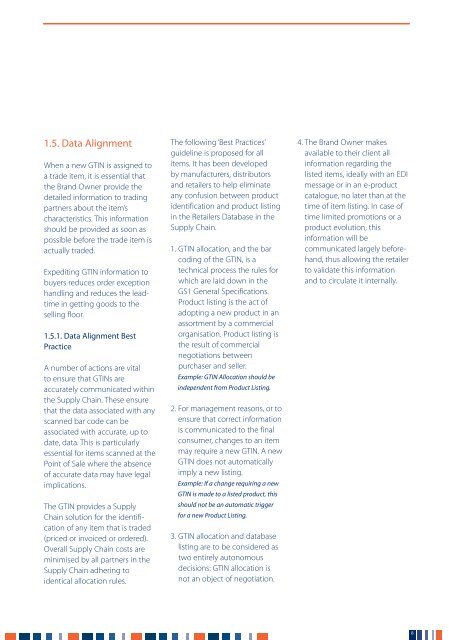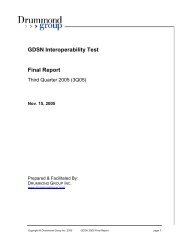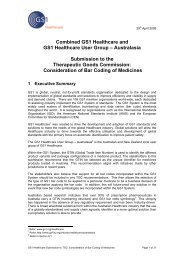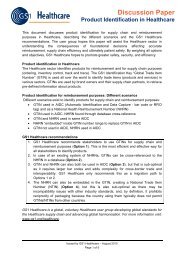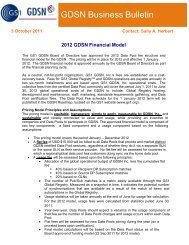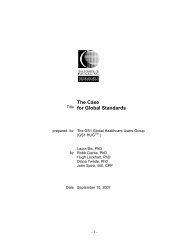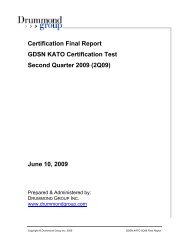GS1 GTIN Allocation Rules
GS1 GTIN Allocation Rules
GS1 GTIN Allocation Rules
Create successful ePaper yourself
Turn your PDF publications into a flip-book with our unique Google optimized e-Paper software.
1.5. Data Alignment<br />
When a new <strong>GTIN</strong> is assigned to<br />
a trade item, it is essential that<br />
the Brand Owner provide the<br />
detailed information to trading<br />
partners about the item’s<br />
characteristics. This information<br />
should be provided as soon as<br />
possible before the trade item is<br />
actually traded.<br />
Expediting <strong>GTIN</strong> information to<br />
buyers reduces order exception<br />
handling and reduces the leadtime<br />
in getting goods to the<br />
selling floor.<br />
1.5.1. Data Alignment Best<br />
Practice<br />
A number of actions are vital<br />
to ensure that <strong>GTIN</strong>s are<br />
accurately communicated within<br />
the Supply Chain. These ensure<br />
that the data associated with any<br />
scanned bar code can be<br />
associated with accurate, up to<br />
date, data. This is particularly<br />
essential for items scanned at the<br />
Point of Sale where the absence<br />
of accurate data may have legal<br />
implications.<br />
The <strong>GTIN</strong> provides a Supply<br />
Chain solution for the identification<br />
of any item that is traded<br />
(priced or invoiced or ordered).<br />
Overall Supply Chain costs are<br />
minimised by all partners in the<br />
Supply Chain adhering to<br />
identical allocation rules.<br />
The following ‘Best Practices’<br />
guideline is proposed for all<br />
items. It has been developed<br />
by manufacturers, distributors<br />
and retailers to help eliminate<br />
any confusion between product<br />
identification and product listing<br />
in the Retailers Database in the<br />
Supply Chain.<br />
1. <strong>GTIN</strong> allocation, and the bar<br />
coding of the <strong>GTIN</strong>, is a<br />
technical process the rules for<br />
which are laid down in the<br />
<strong>GS1</strong> General Specifications.<br />
Product listing is the act of<br />
adopting a new product in an<br />
assortment by a commercial<br />
organisation. Product listing is<br />
the result of commercial<br />
negotiations between<br />
purchaser and seller.<br />
Example: <strong>GTIN</strong> <strong>Allocation</strong> should be<br />
independent from Product Listing.<br />
2. For management reasons, or to<br />
ensure that correct information<br />
is communicated to the final<br />
consumer, changes to an item<br />
may require a new <strong>GTIN</strong>. A new<br />
<strong>GTIN</strong> does not automatically<br />
imply a new listing.<br />
Example: If a change requiring a new<br />
<strong>GTIN</strong> is made to a listed product, this<br />
should not be an automatic trigger<br />
for a new Product Listing.<br />
3. <strong>GTIN</strong> allocation and database<br />
listing are to be considered as<br />
two entirely autonomous<br />
decisions: <strong>GTIN</strong> allocation is<br />
not an object of negotiation.<br />
4. The Brand Owner makes<br />
available to their client all<br />
information regarding the<br />
listed items, ideally with an EDI<br />
message or in an e-product<br />
catalogue, no later than at the<br />
time of item listing. In case of<br />
time limited promotions or a<br />
product evolution, this<br />
information will be<br />
communicated largely beforehand,<br />
thus allowing the retailer<br />
to validate this information<br />
and to circulate it internally.<br />
8


